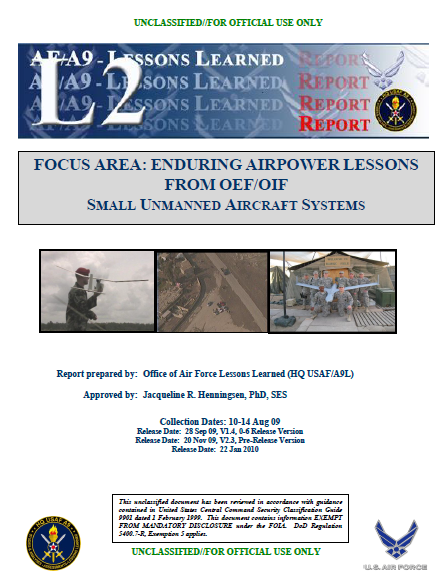ENDURING AIRPOWER LESSONS FROM OEF/OIF SMALL UNMANNED AIRCRAFT SYSTEMS
- 19 pages
- For Official Use Only
- January 22, 2010
“Enduring Airpower Lessons from Operation ENDURING FREEDOM (OEF) and Operation IRAQI FREEDOM (OIF)” is one of three lessons learned (L2) focus areas directed by the Chief of Staff of the Air Force (CSAF) at CORONA Top 2008. This report is the third and last in a series of Unmanned Aircraft Systems (UAS) L2 reports produced for fiscal year 2009 and focuses on Small UAS (SUAS) capabilities and issues.
Five key observations provide insight into SUAS issues:
OBSERVATION 1: Insufficient analysis and education exist on the capabilities of SUAS and how they could be effectively employed by the USAF.
OBSERVATION 2: The USAF does not have a comprehensive strategy for the acquisition, sustainment and development of SUAS capabilities; and the USAF has not properly funded SUAS programs.
OBSERVATION 3: HQ AFSOC received funding and has developed the first Air Force SUAS Formal Training Unit (FTU).
OBSERVATION 4: There are no full-time, dedicated professional uniformed Group 2 and 3 UAS operators and maintainers.
OBSERVATION 5: Frequency and bandwidth management, communications infrastructure and datalinks will only be more stressed with the proliferation of SUAS; and SUAS Ground Control Station (GCS) frequencies are unencrypted and unprotected.
…
OBSERVATION 5: Frequency and bandwidth management, communications infrastructure and datalinks will only be more stressed with the proliferation of SUAS; and SUAS GCS frequencies are unencrypted and unprotected.
Discussion: With the proliferation of SUAS on the battlefield of the near future, the current SUAS GCS proprietary datalinks are not flexible and sustainable. Many of the current SUAS use datalink equipment that is not interoperable with other datalinks or tunable to other frequencies. In fact, the number of available proprietary SUAS frequencies is so limited US military SUAS operations are threatened by interference from other operations. Additionally, SUAS datalinks are unencrypted and are thus susceptible to enemy exploitation. Since datalinks are also unprotected, GCS are jammable and locations can even be triangulated and possibly physically attacked.
Not all Group 2 and 3 UAS are Cursor on Target (CoT) capable. Among other capabilities, CoT enables users to communicate from a common set of applications to various datalinks such as Link-16 and Situational Awareness Data Link (SADL). Any GCS standards must deliver CoT compatibility to enable existing CoT systems to seamlessly integrate, thereby decreasing integration costs and simplifying transition.
Given that SUAS datalink frequencies are not tunable, they may be prohibited from operating in other regions and countries of the world. This limitation is due to the potentiality of interfering with host-nation communications frequencies. Additionally, SUAS datalinks are not interoperable with manpack radios, burdening operators to transport multiple pieces of communications hardware on the battlefield.
Effective 1 October 2009, Assistant Secretary of Defense (Networks and Information Integration) (ASD (NII)) mandated the use of Common Data Link (CDL) for all UAS greater than 30 lbs. As it was originally designed and fielded in the late 1970s, CDL was adequate. According to HQ AFSOC, CDL is not small enough for Group 1 SUAS operations, but will be leveraged on Group 2 and 3 systems. However, the continued proliferation of CDL enabled airborne assets has already reached a tipping point. CDL is a huge and inefficient frequency space consumer. This dated, yet capable, waveform needs modernization, to include “dial-a-rate” speeds, more efficient error correction coding, multiple encoding rates, expanded frequency band alternatives (e.g., into L, S, C and extended Ku) and importability to software defined radios. Such modifications could improve UAS density 3 to 15 times what it is today. As it stands, failure to modernize the CDL waveform will limit the number of participants that can operate within a region (or suffer degraded video quality) and require strict frequency deconfliction.
Lessons Identified:
- Develop tunable, interoperable, and unrestricted SUAS GCS frequencies since available radio frequency spectrum is an essential enabler for UAS operations.
- Secure and protect SUAS GCS frequencies.
- Develop SUAS GCS datalinks capable of Voice-Over Internet Protocol (VoIP), video and data multicast.
- Make all Group 2 and 3 UAS CoT capable.
- Develop digital SUAS GCS datalinks that are interoperable with field radios.
- Modernize CDL waveform.

